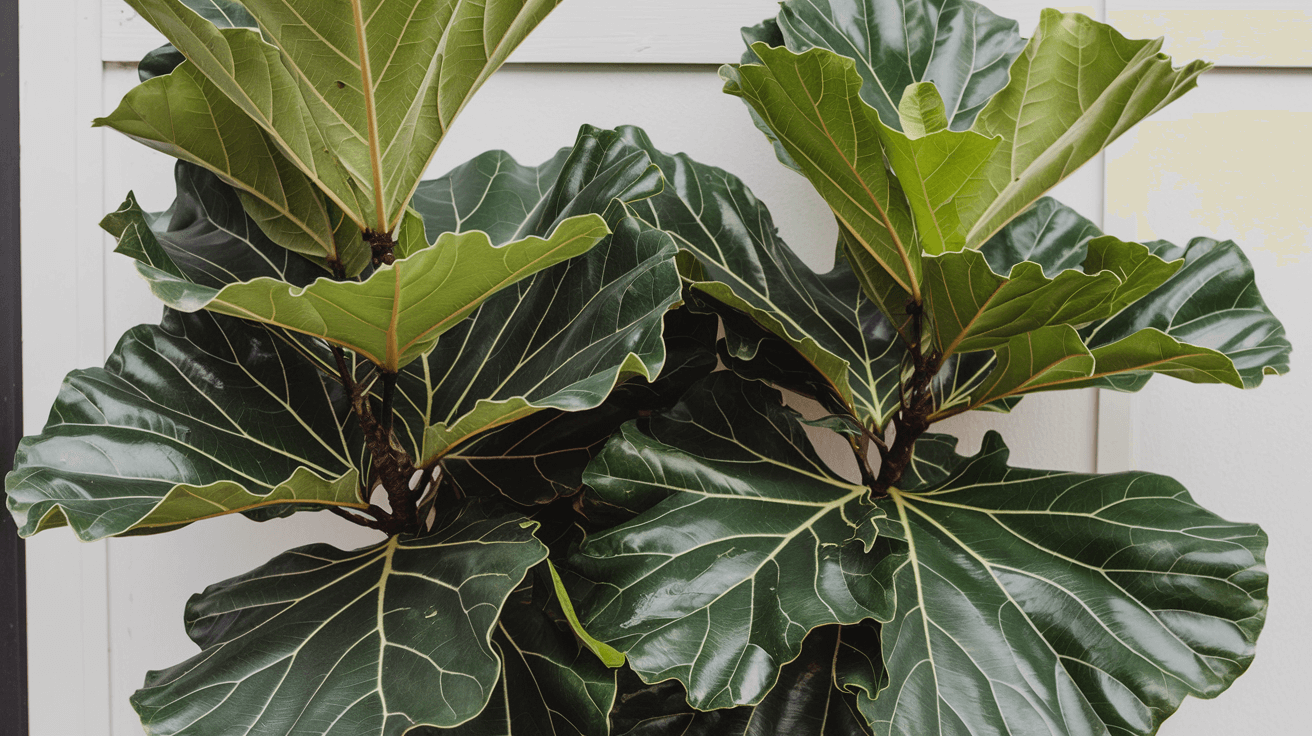Those glossy, vibrant fiddle leaf fig leaves you see in design magazines don’t achieve that lustrous appearance by accident. Within weeks of bringing a fiddle home, many owners notice their once-shiny leaves developing a dull, dusty film that dims the plant’s visual impact.
The accumulation isn’t just cosmetic—dust and residue actually interfere with photosynthesis, reducing the plant’s ability to produce energy and grow.
I’ve maintained dozens of fiddles over the years and learned that regular leaf cleaning is one of the simplest yet most transformative care practices, taking just 10-15 minutes monthly while dramatically improving both appearance and health.
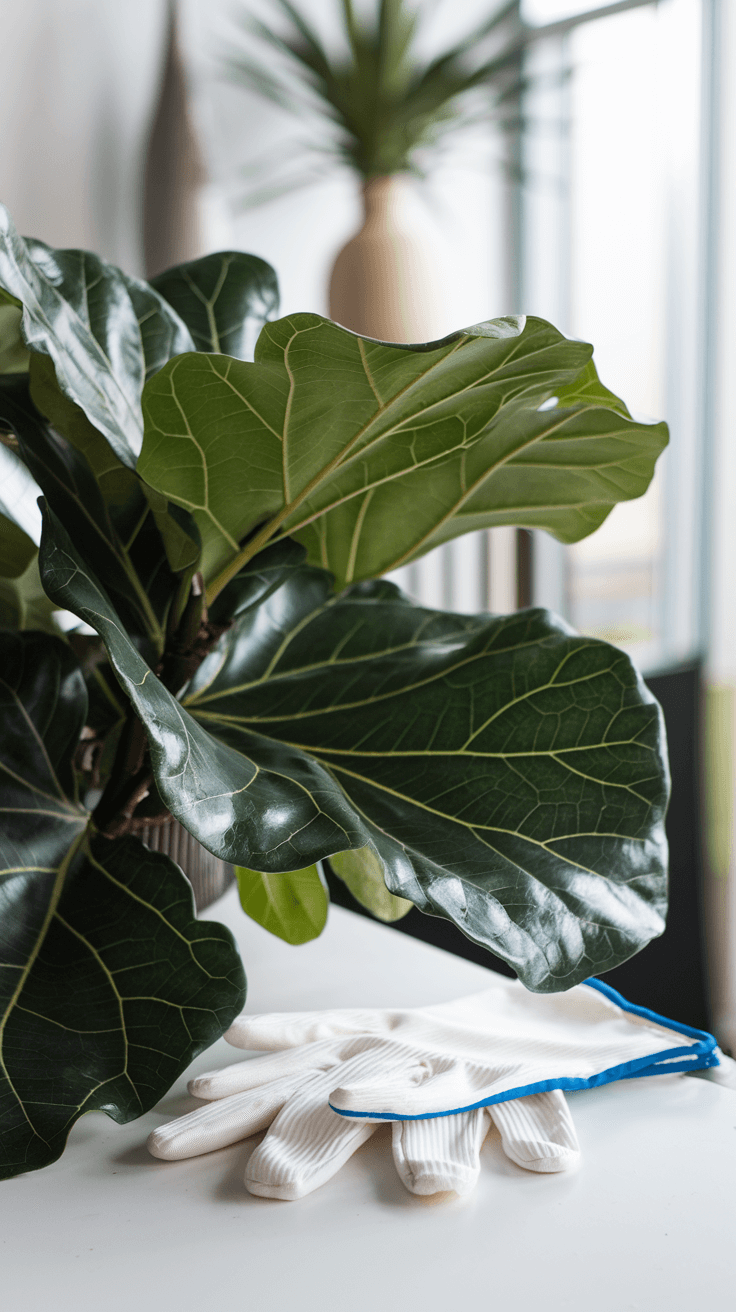
The challenge is that improper cleaning techniques can damage those delicate leaves, leaving water spots, scratches, or even removing the natural waxy coating that provides their signature shine.
Commercial leaf shine products promise quick results but often create buildup that attracts more dust and can clog leaf pores.
This guide reveals the most effective cleaning methods I’ve developed through years of trial and refinement, covering exactly what to use, proper technique to avoid damage, how often cleaning is necessary, and which mistakes to avoid that can leave your fiddle looking worse rather than better.
Why Regular Leaf Cleaning Matters
Dust accumulation on fiddle leaf fig leaves blocks sunlight from reaching the leaf surface, directly reducing photosynthetic efficiency. Even a thin layer of dust can decrease light absorption by 20-30%, essentially starving your plant of the energy it needs for growth.
In homes near busy streets, with forced-air heating systems, or in dry climates, dust buildup occurs rapidly—sometimes requiring cleaning every 2-3 weeks rather than monthly.
Beyond photosynthesis, dirty leaves create perfect conditions for pest infestations. Spider mites, in particular, thrive in dusty conditions, using the accumulated debris as cover while feeding on leaf tissue. Regular cleaning disrupts pest establishment and allows you to spot early infestations during your inspection routine.
I’ve caught numerous pest problems in their initial stages simply because I was handling leaves during cleaning, noticing the telltale webbing or tiny insects before populations exploded.
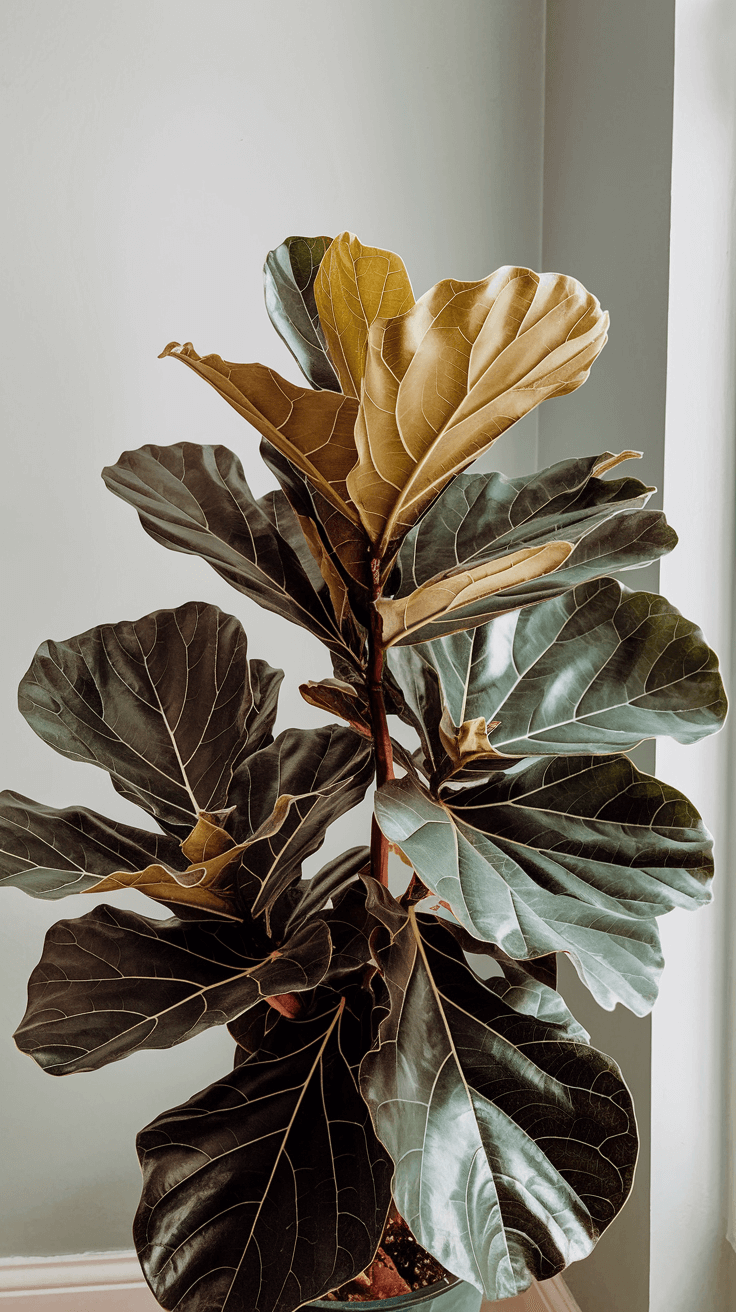
The aesthetic impact is undeniable. Clean, shiny fiddle leaves reflect light beautifully, creating that showroom appearance that makes these plants so desirable. Dull, dusty leaves make even healthy plants look neglected and diminish the entire room’s ambiance.
Since fiddles are often focal point plants in interior design, maintaining their visual appeal matters beyond simple plant care—it’s part of your overall home presentation.
The natural waxy cuticle on fiddle leaves provides inherent shine when clean. This protective layer evolved to repel water in their native rainforest habitat, and when free of debris, it creates that glossy finish naturally.
Commercial leaf shine products attempt to enhance this, but they often work against the leaf’s natural properties, creating an artificial coating that requires frequent reapplication and can cause long-term problems.
Pro tip: Establish a cleaning schedule tied to your regular watering routine—every second or third watering, spend the extra 10 minutes cleaning leaves. This consistency prevents heavy buildup that’s harder to remove and keeps your fiddle looking its best continuously rather than cycling between grimy and clean.
The Best Cleaning Methods and Materials
Plain lukewarm water on a soft, damp cloth is the safest and most effective cleaning solution for the majority of situations. Microfiber cloths work exceptionally well because their fine fibers lift dust without scratching, and they’re absorbent enough to avoid leaving water streaks.
Avoid paper towels, which are abrasive and leave lint, or rough fabrics that can damage the leaf surface or remove the natural waxy coating.
For stubborn residue or sticky buildup from pest honeydew, a mild solution works better than plain water. Mix a few drops of gentle dish soap (unscented, without additives) into a bowl of lukewarm water—just enough to create slight suds.
This breaks down oils, sticky substances, and stubborn grime without harsh chemicals that could damage leaves. Always follow soap cleaning with a plain water rinse to remove residue.
Distilled or filtered water prevents the water spots and mineral deposits that tap water leaves behind. If you’ve ever noticed white, chalky marks on your fiddle leaves after cleaning, that’s mineral content from hard water evaporating and leaving deposits.
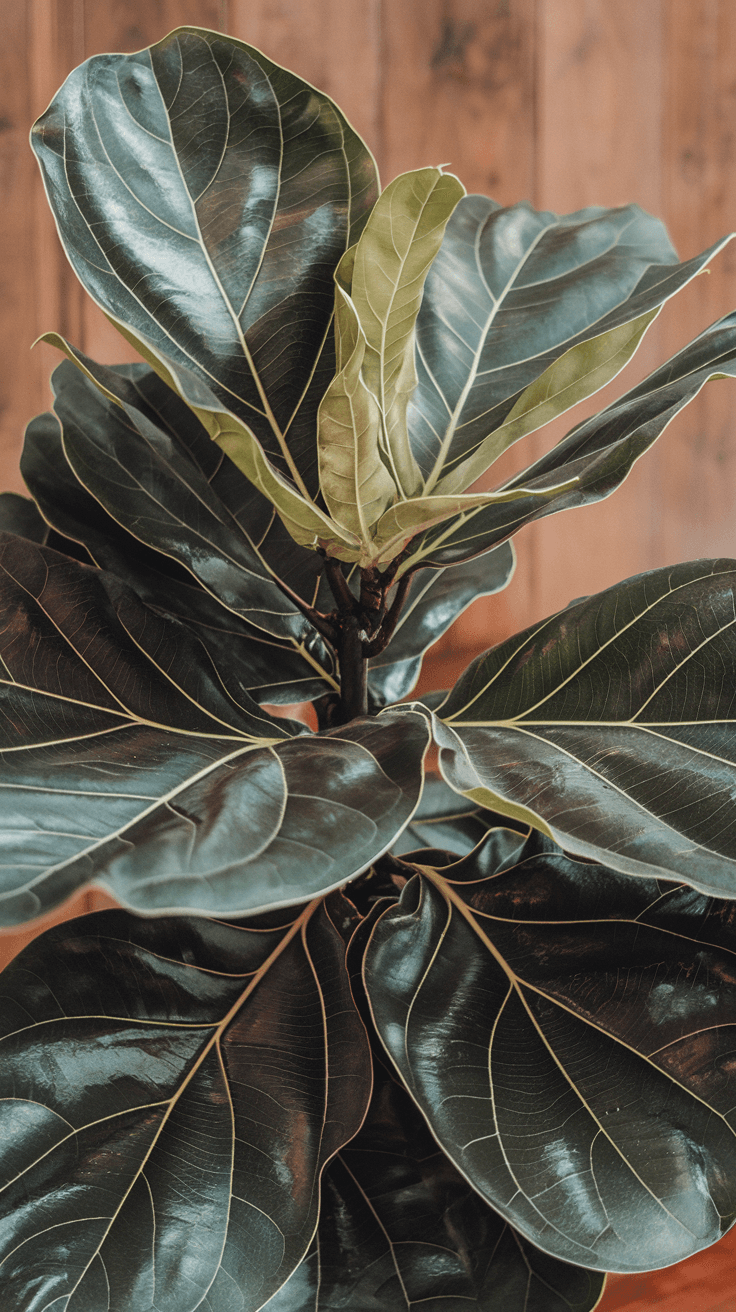
These spots are difficult to remove once they’ve dried and accumulate over multiple cleanings. In areas with very hard water, switching to distilled water for leaf cleaning makes a significant difference in final appearance.
Natural shine enhancers like diluted neem oil serve dual purposes—they leave a subtle shine while providing pest prevention. Mix one teaspoon of neem oil with one quart of water and a drop of dish soap (which helps the oil emulsify). Apply sparingly with a cloth, then buff gently.
This method works well for plants that seem prone to spider mites, combining cleaning with preventative care. However, use this monthly at most—overuse can create buildup.
Expert insight: Never use commercial leaf shine products, mayonnaise, olive oil, or other home remedies that promise increased gloss. These substances clog the leaf’s stomata (breathing pores), create sticky surfaces that attract more dust, and can cause bacterial or fungal growth over time. The temporary shine isn’t worth the long-term damage.
Step-by-Step Cleaning Process
Begin by preparing your cleaning station with all materials within reach—cloth, water bowl, a second cloth for drying/buffing, and something to protect your floor from drips. Work in good lighting so you can see what you’re cleaning and inspect for any issues.
Room temperature matters; avoid cleaning immediately after watering or when leaves are cold from winter drafts, as temperature shock can cause spotting.
Support each leaf gently from beneath with one hand while cleaning the top surface with your dampened cloth in the other hand. This support prevents bending or tearing, particularly important for large, heavy leaves.
Wipe from the base of the leaf toward the tip, following the natural vein direction. Use gentle pressure—you’re removing dust, not scrubbing a countertop. The goal is lifting debris without abrading the leaf surface.
Flip your cloth frequently to clean areas rather than redistributing dirt. I typically fold my microfiber cloth into quarters, giving me eight clean surfaces before needing to rinse. When the cloth becomes noticeably dirty, rinse it thoroughly in clean water, wring it until just damp, and continue.
Using a dirty cloth just spreads grime around rather than removing it.
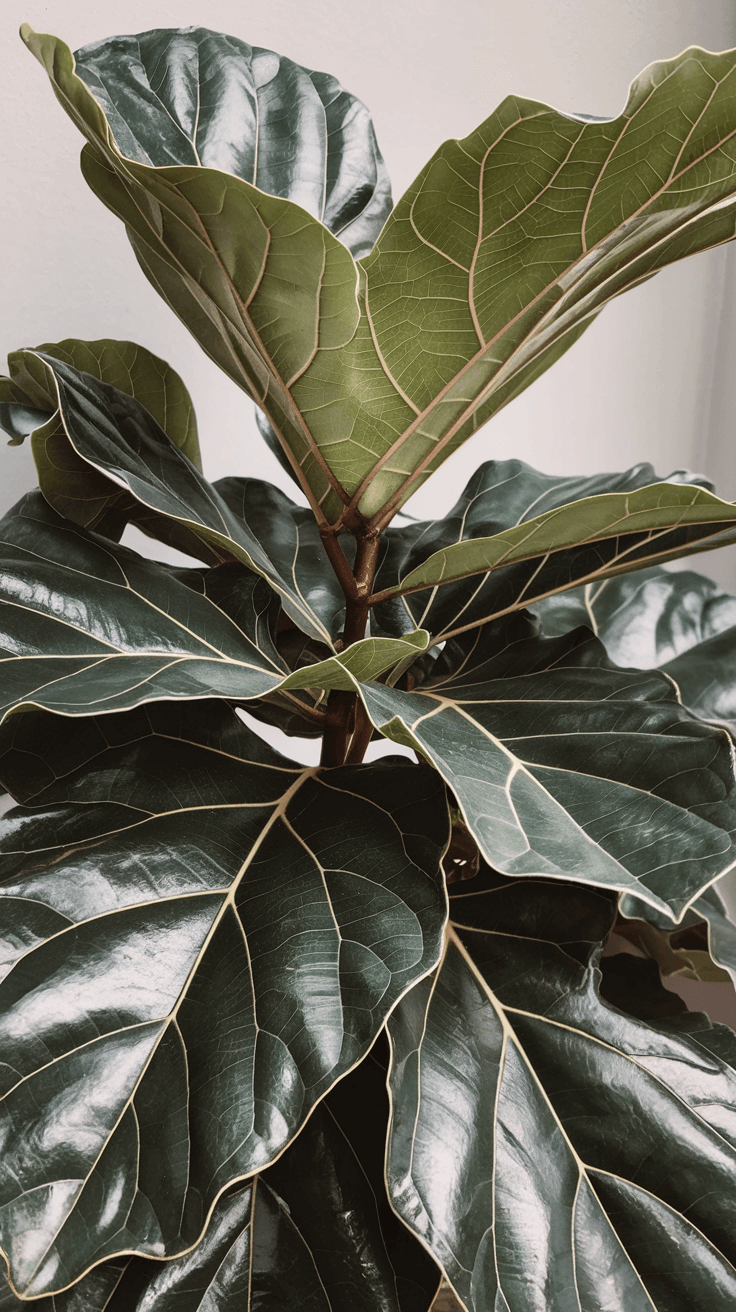
Don’t forget leaf undersides, where dust accumulates and pests hide. The underside cleaning requires even more gentleness since this surface is more delicate than the top. Use the same base-to-tip wiping motion with very light pressure. This is your opportunity to inspect for pests—look for webbing, tiny moving dots, or sticky residue that indicates problems.
After cleaning all leaves, do a final buff with a clean, dry microfiber cloth to remove any remaining water droplets and enhance shine. This buffing step makes a noticeable difference in the final glossy appearance, similar to buffing windows after cleaning.
Use circular motions with minimal pressure, working over each leaf surface quickly.
Action step: Start with your fiddle’s lowest, smallest leaves as practice before tackling the large upper leaves. This builds confidence with your technique and ensures you don’t damage the most prominent foliage if you’re still refining your method.
Common Mistakes That Damage Leaves
Using too much water or leaving leaves dripping wet invites fungal and bacterial problems. Water pooling in the leaf’s center where the stem attaches can cause rot that spreads into the plant’s main structure.
Your cloth should be damp enough to clean effectively but not so wet that it drips or leaves the leaf visibly wet. After wiping, leaves should dry naturally within 10-15 minutes.
Scrubbing too hard or using abrasive materials removes the protective waxy cuticle that gives fiddles their natural shine. Once damaged, this coating takes weeks to regenerate, leaving leaves dull and more vulnerable to pests and disease.
If you notice leaves becoming progressively duller despite regular cleaning, you’re likely being too aggressive. Lighten your pressure and ensure your cloth is truly soft.
Cleaning in direct sunlight creates water spots as droplets act as magnifying glasses, intensifying sun rays onto the leaf surface. This can actually burn the leaf tissue, creating permanent brown marks.
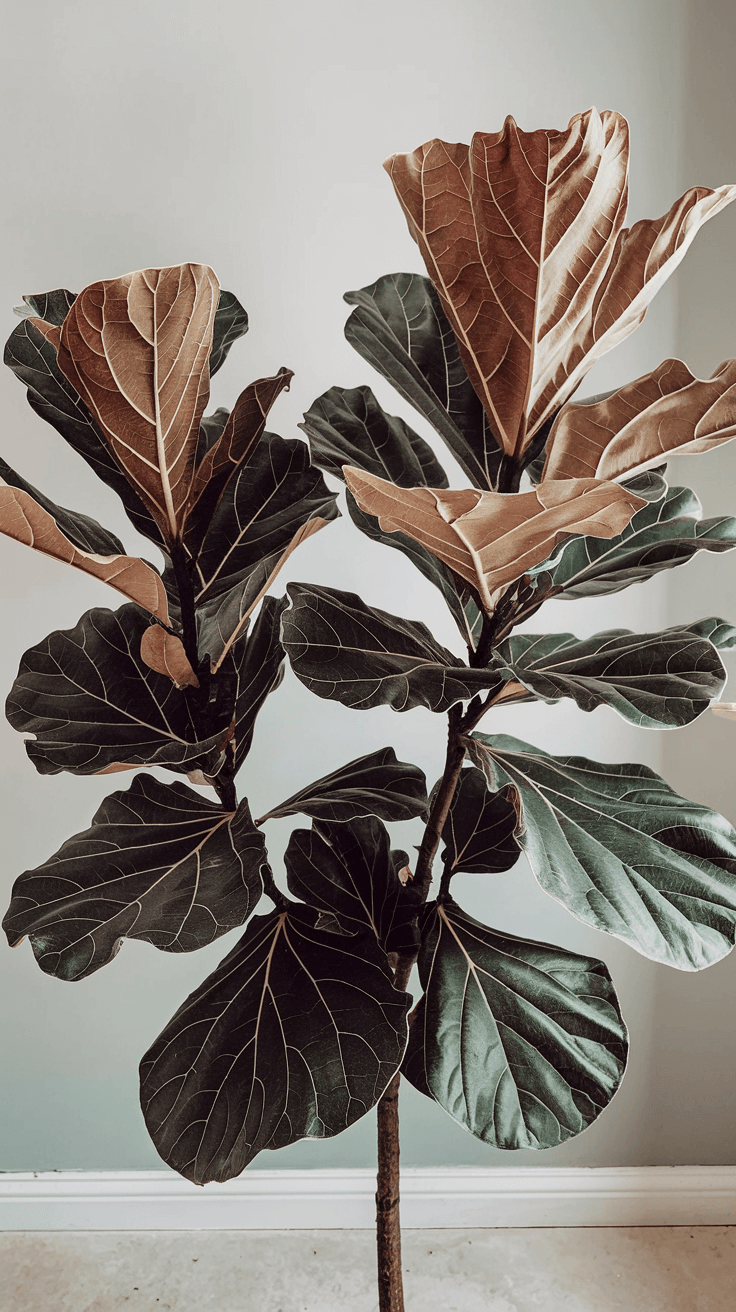
Clean in the morning or evening when your fiddle isn’t receiving direct sun exposure, or temporarily move it to a shaded location for the cleaning session.
Neglecting to clean new growth is a missed opportunity. Those fresh, unfurling leaves are delicate but benefit from gentle cleaning once fully open. However, wait until new leaves have hardened—typically 2-3 weeks after unfurling—before including them in your cleaning routine.
Cleaning too-fresh leaves can damage their still-developing structure.
Using commercial chemical cleaners designed for hard surfaces or even commercial plant shine products causes more problems than it solves. These products leave residue that accumulates, clogs leaf pores, and creates sticky surfaces.
I’ve rehabilitated fiddles where owners used these products regularly, requiring multiple cleanings to remove the buildup before the natural leaf shine could return.
Maintaining Long-Term Leaf Health and Shine
Humidity management reduces dust accumulation. Dry air allows more dust particles to remain suspended and settle on horizontal surfaces, including your fiddle’s leaves.
Maintaining 40-60% relative humidity through humidifiers or grouping plants together creates a microclimate where dust settles less readily and leaves stay cleaner longer.
Strategic placement away from high-traffic areas, heating vents, and exterior doors minimizes dust exposure. Air currents from forced-air systems carry tremendous amounts of dust, while exterior doors allow outdoor pollutants inside every time they open.
If your fiddle occupies a high-dust location, accept that more frequent cleaning will be necessary or consider relocating for easier maintenance.
Air purifiers in the same room as your fiddle can significantly reduce airborne dust, benefiting both your plant and your own respiratory health.
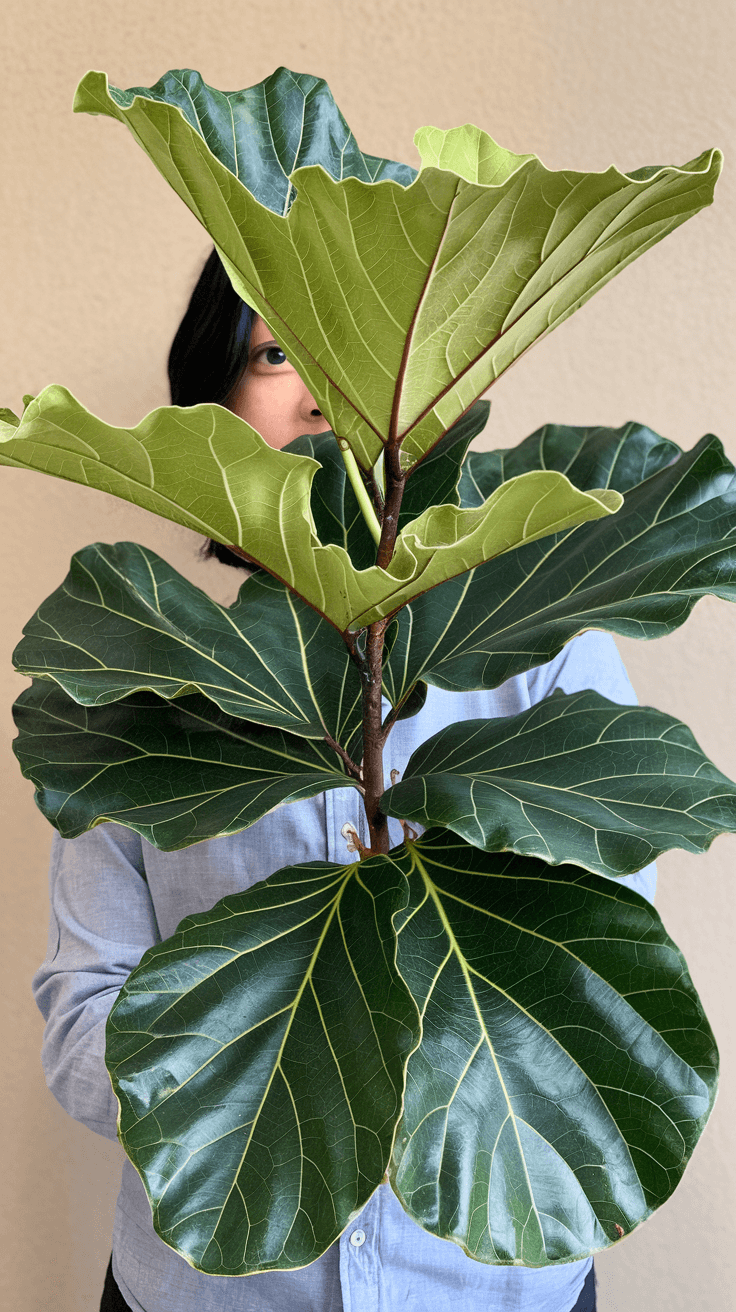
HEPA filters capture the fine particles that would otherwise settle on leaves, potentially extending cleaning intervals from every 3 weeks to every 4-6 weeks in homes with persistent dust issues.
Consistent watering and appropriate light optimize the natural waxy cuticle production that gives fiddles their shine. Stressed plants produce thinner, less glossy leaves that don’t look their best even when perfectly clean.
The foundation of shiny leaves is overall plant health—cleaning simply maintains and reveals that natural beauty.
Conclusion: Clean Leaves, Thriving Plant
Regular leaf cleaning represents one of those plant care tasks that delivers results far exceeding the minimal effort required.
The 10-15 minutes you invest monthly yields dramatic improvements in both plant health and aesthetic appeal, ensuring your fiddle performs its photosynthetic functions efficiently while maintaining the showpiece appearance that makes these plants design favorites.
The key is consistency and proper technique—gentle cleaning with appropriate materials on a regular schedule rather than infrequent aggressive scrubbing when leaves become obviously grimy.
Remember that you’re working with living tissue that has natural protective coatings; your goal is supporting and revealing the plant’s inherent beauty rather than applying artificial enhancements that cause long-term problems.
When you combine regular cleaning with optimal care in other areas—proper light, appropriate watering, suitable humidity—your fiddle leaf fig will display that enviable glossy appearance continuously, looking as impressive in your home as the specimens featured in design magazines.
The shine you’re maintaining isn’t just superficial beauty; it’s the visible expression of a healthy, thriving plant that’s receiving the attentive care it needs to flourish.

